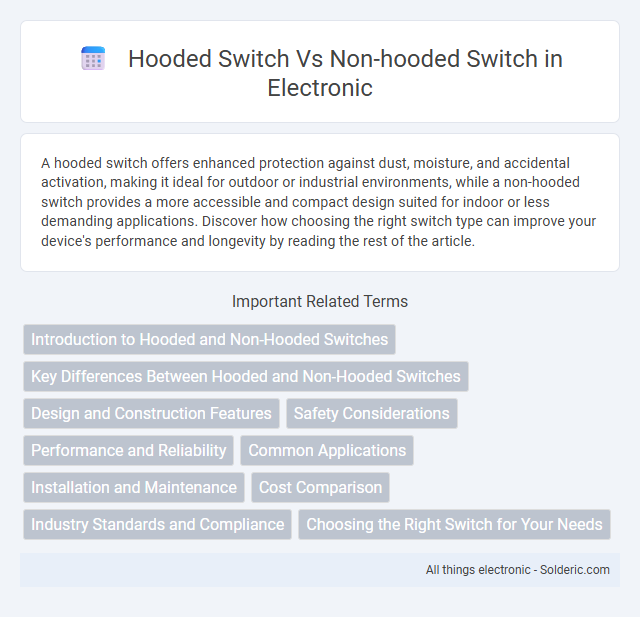A hooded switch offers enhanced protection against dust, moisture, and accidental activation, making it ideal for outdoor or industrial environments, while a non-hooded switch provides a more accessible and compact design suited for indoor or less demanding applications. Discover how choosing the right switch type can improve your device's performance and longevity by reading the rest of the article.
Comparison Table
| Feature | Hooded Switch | Non-Hooded Switch |
|---|---|---|
| Design | Switch enclosed with a protective hood | Exposed switch without protective covering |
| Protection | Resists dust, debris, and accidental activation | Vulnerable to dust and accidental presses |
| Durability | Higher durability due to protection | Lower durability, prone to damage |
| Usability | Requires deliberate action to activate | Quick and easy to trigger |
| Applications | Industrial, safety-critical environments | General use, low-risk environments |
| Cost | Typically higher due to added protection | Lower cost, simpler design |
Introduction to Hooded and Non-Hooded Switches
Hooded switches feature a protective casing that guards the switch mechanism from dust, moisture, and accidental activation, making them ideal for outdoor or industrial applications. Non-hooded switches lack this covering, offering a more exposed design suited for indoor or less harsh environments. Your choice between hooded and non-hooded switches depends on the level of protection and durability required for your specific project or installation.
Key Differences Between Hooded and Non-Hooded Switches
Hooded switches feature a protective covering that shields the switch mechanism from dust, moisture, and accidental activation, enhancing durability and reliability in harsh environments. Non-hooded switches lack this protective enclosure, making them more susceptible to environmental factors but allowing for easier access and faster operation. Your choice depends on the application requirements, balancing protection against accessibility and responsiveness.
Design and Construction Features
Hooded switches feature a protective cover that prevents accidental activation, enhancing safety in various industrial and mechanical applications. Non-hooded switches have a more exposed design, allowing for quicker access but increasing the risk of unintentional triggering. Your choice depends on whether you prioritize protection and durability or ease of use and rapid response.
Safety Considerations
A hooded switch offers enhanced safety by providing a protective cover that reduces accidental activation and prevents dust or moisture ingress, ensuring reliable operation in hazardous environments. Non-hooded switches expose the actuator directly, increasing the risk of unintentional switching and potential electrical hazards, especially in industrial or outdoor settings. Choosing a hooded switch improves your safety by minimizing accidental contact and environmental damage, making it ideal for applications requiring robust protection.
Performance and Reliability
Hooded switches provide enhanced protection against dust and debris, significantly improving durability and maintaining consistent performance in harsh environments compared to non-hooded switches. Non-hooded switches, while generally more accessible and cost-effective, may experience reduced reliability in high-exposure settings due to increased susceptibility to contaminants. Your choice between the two should consider the specific operational conditions to ensure optimal switch longevity and performance.
Common Applications
Hooded switches are commonly used in industrial equipment and outdoor machinery where protection from dust, moisture, and physical impact is essential, providing enhanced durability and reliability. Non-hooded switches are typically found in indoor applications such as household appliances, consumer electronics, and control panels where environmental protection is less critical. The choice between hooded and non-hooded switches largely depends on the operating environment and the need for additional safeguarding against contaminants and accidental activation.
Installation and Maintenance
Hooded switches offer easier installation and maintenance due to their protective covers that shield the internal components from dust, moisture, and accidental damage, reducing the frequency of repairs and cleaning. Non-hooded switches, while simpler in design, require more frequent maintenance checks and are more susceptible to environmental wear, potentially leading to shorter service intervals. Your choice should consider the installation environment and the desired balance between upfront effort and long-term upkeep.
Cost Comparison
Hooded switches generally cost more than non-hooded switches due to their enhanced protection against dust, moisture, and potential electrical hazards. The added materials and manufacturing complexity of hooded switches increase their price point, making non-hooded switches a more budget-friendly option for environments with minimal exposure to contaminants. Industries prioritizing durability and safety often justify the higher investment in hooded switches despite the cost premium.
Industry Standards and Compliance
Hooded switches meet stringent industry standards such as IEC 61058 and UL 61058 for enhanced protection against dust, water, and accidental activation, making them ideal for harsh environments. Non-hooded switches, while compliant with basic electrical safety standards, often lack the additional sealing required for IP-rated certifications. This difference affects their suitability in applications requiring robust compliance with environmental and safety regulations.
Choosing the Right Switch for Your Needs
Hooded switches provide dust and moisture protection, making them ideal for outdoor or industrial environments where durability is crucial. Non-hooded switches offer easier access and quicker operation, suited for indoor or low-exposure applications where aesthetics and convenience are priorities. Selecting the appropriate switch depends on environmental conditions, usage frequency, and required resilience.
hooded switch vs non-hooded switch Infographic

 solderic.com
solderic.com